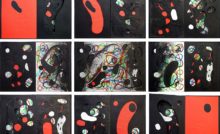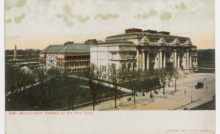The Joy of Living: a traditional analysis of the last artwork of the year.


[EN] / [IT]
Helpless objects being observed
This time I decided to be good, playing with precision and predictability, staying on the traditionalist track of ‘criticising’ art.
That in the end, why strive to be innovative in a country where the way of making, presenting and talking about art is anchored to dead, didactic and too often ‘academic’ ways?
Are we still talking about art in terms of helpless objects being observed?
The few things of contemporary aspiration that I have seen in the public and institutional spheres in recent times point to the opportunities of Instagrammable art, which seems misleading to me; for the rest, the art field is still riddled with stereotypes and clichés that are years old, where for example the artist’s name is worth more than his product. This is not the time to address certain discourses, but it is becoming increasingly clear to me that the concept of art is broadening and changing, with boundaries that are less and less tangent and defined. This is wonderful, as long as one is able to keep alive the pulsating opportunity that a work gives to broaden one’s gaze. Art is capable of moving the beholder, it impacts the observer; instead, art making and its curatorship are increasingly being adapted to schematisations and formats functional to the public’s enjoyment, hence a drift towards approximation and repetition. More than anything else, instead of showing different things, what reassures the public is repeated: it is lulled into its masturbation of feeling culturally elevated, because it knows and observes what it has always seen and observed, what is recognised by the elite and the art market. Moreover, great influence on the artistic narrative in Italy today is the extreme confusion between aesthetics (from Gr. αἴσϑησις ‘sensation’, ‘perception’, ‘ability to feel’, ‘sensibility’) and appearance (what appears, what shows itself to the eye; hence appearance, and also demeanour, external behaviour). Different meanings leading to different narratives and dramaturgies when it comes to wanting to communicate to an audience.
But without digressing, today I challenged myself to be traditionalist, otherwise I always come across as the odd one out, and decided to do an analysis of a painting, one of my favourite works: Henri Matisse’s ‘Joie de vivre’.
1906, oil on canvas, 176.5×240.7 cm, kept at the Barnes Foundation in Philadelphia.
The Title:
Let us begin with the title, which in this work, as in many others, is the narrative pivot that enables the emotional exchange between the viewer and the artist. Words are important: naming things is the ability to know that they are real, that they are present, and this is what happens in art, where the title of a work is often the bridge that allows the approach. In fact, on the contrary, it sometimes happens that ‘art’, rather than uniting different perspectives, creates distance and misunderstanding. It is not a question of demonising the less pleasant sensations, because even feeling rejection towards a work of art confirms its ability to transmit; it is instead a question of the type of sensation: feeling distant does not allow for a reflective space; if no common ground is found between the ‘I’ who observes and the work, then there is no exchange and perhaps not even art.
Instead, when an artist is clear about where he wants to position his audience, he is able to give the right input to generate this reflective space.’Joie de vivre’ is a very convincing title, because it stimulates a wide-ranging and immediately generates questions: the painting is about human life and asks “where does joy lie?”. Matisse’s masterstroke is to play fast and use the simplicity of images, signs and even meanings to answer an important and dense philosophical question. It is not didactic but instead it is unsettling, because it gets to the heart of existence, removing all doubt from the viewer. The title is already a reflexive space.
The Characters:
Wild bodies, stripped of all identities and labels. Bodies free in expressing the most natural ways of the relationship between human and nature. Faeces, hugs, dancing and music. Is it really that easy to get back to basics? Absolutely, and when you understand this, the world changes colours and energy flows between beings without distinction of any kind. The magic of union lies in communication through pleasure, this is joy and also the ultimate meaning of life. I don’t want to talk about a return to ‘primitivism’ because I don’t believe this detachment exists: we are human beings and everything about the body belongs to us. To think that this was only true in the distant past has led us to believe that evolution lies in the intellect and to separate mind from matter: what we feel from what we do. Matisse, on the other hand, with his fluid and sinuous strokes, unites different characters in a single composition and gives us variety: freedom to be in the open, freedom to aim for joy as a life mission, each in his or her own way, in the union and sharing of space, body and spirit. Acceptance.
Colours:
The colours are those of wonder and the sublime, of delicacy and lightness. Of the sun that illuminates and the shade that refreshes, of the sea that changes and the skin that changes colours and moods. In the surreal and natural colours, Matisse manages to unify everything without letting anything slip through his fingers: passionate red, earthy brown, harmonious green, skin pink, light yellow, indigo and mystical violet. Rainbow, natural spectrum of human, light and emotion; they are all there, together, mixed on the canvas creating an image that is movement.
References:
There are many references to other artists in the work, both in style and composition. I want to believe that Matisse, rather than paying homage, wanted to unite different artists and works within the same painting. As if to say: “the joy of living is in being together, all of us, artists and works, humans and nature, art and life.” So here are the bathers and women lying on the grass, a tropical beach and so many bodies in contact: Gauguin, Cézanne, Titian and Manet; here they each shine on their own piece of the stage, all together keeping each other company, in that dance on canvas that is life.
Thank you Matisse, for leaving us a work that is much more than a defenceless object, but instead breathes, provokes, shines its own light and perhaps illuminates other human beings with inspiration.
Recent Posts
The older you get, the more you appreciate abstract art
[EN] / [IT] Abstract exists Sheet With Overall Curved Abstract Pattern, Anonymous I started experimenting with abstract…
From Teotihuacan to Tenochtitlán: in the National Museum of Anthropology to learn about Mexico
[EN] / [IT] In this new article, I would like to try to recount my…
What would happen if the Met was destroyed? Questions and answers to an artificial intelligence
[EN] / [IT] Destruction and provocation The recent fall and destruction of Jeff Koons' work…
Botticelli is the best version of ourselves
[EN] / [IT] Who does not know Botticelli? Alessandro di Mariano di Vanni Filipepi known…
Fish Magic and the circular journey of the unconscious
[EN] / [IT] BUY THE 'FISH MAGIC' POSTER HERE: Fish Magic by Paul Klee –…
Open, wait, accept and cut: pain like Lucio Fontana
[EN] / [IT] And I just wanted to let in some light.I was misunderstood as…


